Parental Substance Misuse
Last Modified 28/03/2023 16:50:59
Share this page
This section examines the scale of substance misuse among parents living in Blackpool.
Children Living with Alcohol Misusing Parents
Children Living with Drug Misusing Parents
Children Living with Parents Experiencing Mental Ill-health
Definitions
Increasing risk/hazardous drinkers
People in the increasing risk group, the higher risk group and dependent group are considered to be misusing alcohol. Increasing risk drinking or hazardous drinking is the largest group of people misusing alcohol and is made up of those who regularly drink over the recommended limits for lower risk drinking but are not regularly drinking at higher risk levels. The technical definition for this group is a man whose average weekly alcohol consumption is >21 units and <=50 units in the previous 12 months or a woman whose average weekly alcohol consumption is >14 units and <=35 units in the previous 12 months.
Higher risk/harmful drinkers
This group regularly drink well over the recommended limits. Higher risk/harmful drinkers are men who regularly drink more than 50 units a week or eight units a day; and women who regularly drink more than 35 units a week or six units a day.
Although a smaller group than increasing risk drinkers, this group is at much greater risk of the wide range of alcohol-related health harms and the consequent costs, and so effective prevention and treatment can have a particularly powerful benefit in individuals who receive them.
Dependent Drinkers
Alcohol dependence is a particular form of higher risk drinking and has a particular set of characteristics. Rather than being defined by intake, dependency is essentially typified by an increased drive to use alcohol and difficulty controlling its use, despite negative consequences. There is also a risk of alcohol withdrawal on stopping drinking.
Binge Drinking
Binge drinkers are a group of people who have episodes of drinking during which they drink to intoxication or to get drunk. This is commonly defined for epidemiological purposes as women drinking more than six units in any one day or men drinking more than eight units in any one day.
National Estimates
The Health Survey for England (HSfE) and General Household Survey (GHS) (both 2004) generate consistent national estimates - 29% of children aged under 16 years in the UK lived with at least one binge drinking parent, 8% with two binge drinking parents and 4% with a lone binge drinking parent. The National Psychiatric Morbidity Survey (NPMS) indicated that national in 2000, 22% of children lived with a hazardous drinker and 6% with a dependant drinker.1
Alcohol Consumption in Blackpool
Public Health England (PHE) has calculated synthetic estimates for the prevalence of various drinking behaviours for local authorities. PHE estimate that 24% of the Blackpool population aged over 16 reports engaging in binge drinking in the period 2007-2008. This is significantly higher than the rate of 20% for England as a whole. PHE also calculates that, in 2009, 26% of the population of Blackpool that does drink alcohol and are aged over 16 drinks at harmful or hazardous levels. This prevalence is broadly similar to the England as a whole.2 848 people aged between 18 and 75 received treatment for alcohol dependence in the period April 2013 to March 2014. This equates to 0.84% of those aged 18 to 75. This is more than double the rate for England as a whole (0.31%).3 Blackpool also sees the highest rate of alcohol related hospital admissions of any local authority in England4 and the highest mortality from liver disease, in those aged under 75, of an local authority in the country.5
The evidence presented above comparing alcohol consumption and drinking behaviour in Blackpool to England suggests that the population of Blackpool are much more likely to engage in risky and harmful drinking behaviours. In light of this it would be reasonable to assume that applying national estimates of parental alcohol misuse to the population of Blackpool will give a minimum estimate for the scale of parental alcohol misuse and is likely to underestimate its extent. The mid 2013 population estimate for the number of under 16s living in Blackpool is 25,478 and the national estimates in relation to parental alcohol misuse has been applied to the this figure in Figure 1.
Figure 1: Minimum estimate of the number of children exposed to parental alcohol misuse in Blackpool
| | National prevalence (%) | Minimum estimate of the number of children in Blackpool |
|---|
| Under 16s living with at least 1 binge drinking parent |
29% |
7,410 |
| Under 16s living with 2 binge drinking parents |
8% |
2,090 |
| Under 16s living with a lone binge drinking parent |
4% |
990 |
| Under 16s living with a parent who engages in hazardous drinking |
22% |
5,600 |
| Under 16s living with a dependent drinker |
6% |
1,530 |
Estimate of Binge Drinking by Ward
Figure 2 shows estimates of binge drinking by ward in Blackpool. This may give an indication of where in the town we might expect to find higher levels of parental alcohol misuse.
Figure 2 - Synthetic Estimate of Binge Drinking by Ward in Blackpool
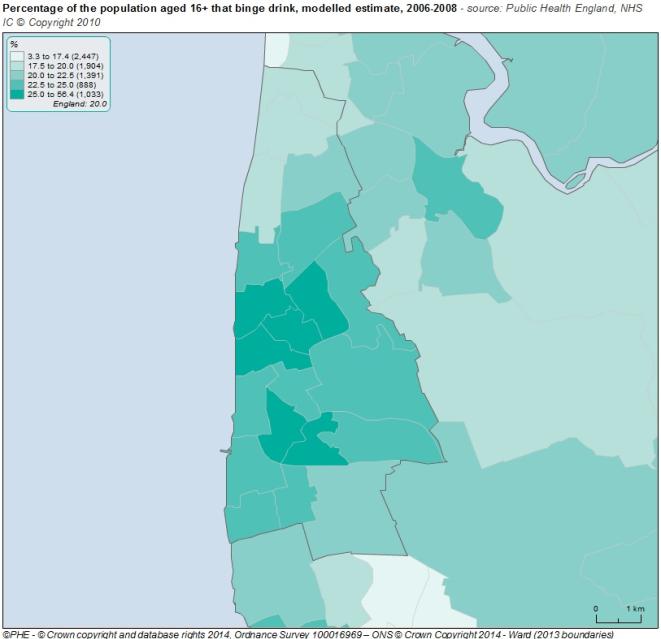 Source: www.localhealth.org.uk/
Source: www.localhealth.org.uk/
Clients in Alcohol Treatment who Identify Themselves as Living with a Child
In the 12 months period, 01/10/2013 to 30/09/2014, 159 Blackpool clients in alcohol treatment lived with children under the age of 18. Therefore, more than 159 children will live with parents in alcohol treatment as many clients will have more than 1 child. The proportion of clients in alcohol treatment who live with children under the age of 18 is similar in Blackpool to the national average, although as we have already identified the Blackpool population aged 18 - 74 has more than double the rate of clients in alcohol treatment when compared with England as a whole.
Period: 01/10/2013 to 30/09/2014
Figure 4 illustrates where clients reside who have undertaken alcohol treatment in the period 01/04/2014 to 31/03/2015 and who live with children.
Figure 4 - Map of Clients in Alcohol Treatment who Live with Children Under the age of 18
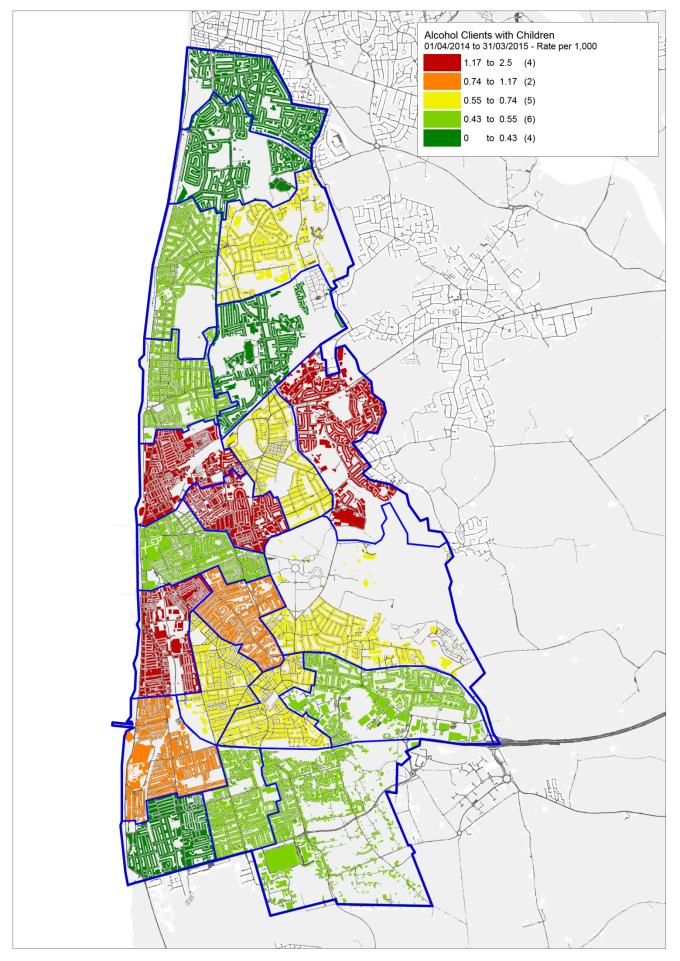
MOSAIC
The MOSAIC population segmentation tool can be used to identify the types of household that are most likely to contain children under the age of five and also households where somebody drinks alcohol every day. Figure 5 below identifies the common MOSAIC types within Blackpool where these two characteristics are most likely to exist together.
It is possible to describe the characteristics of these MOSAIC types and also where households of these MOSIAC types are likely to be located within Blackpool. Figure 6 shows key features of these identified MOSAIC types and figure 7 is a map of where these MOSAIC types can be found in Blackpool.
Figure 6 - Key Features of MOSAIC 2014 Types - Households in Blackpool most likely to include children and persons who drink alcohol daily
|
MOSAIC Type
|
Key Feature 1
|
Key Feature 2
|
Key Feature 3
|
Key Feature 4
|
Key Feature 5
|
Key Feature 6
|
|
H30 - Affordable Fringe
|
Married couples in 30s or 40s
|
Have lived there 5 years or more
|
Own semis in affordable suburbs
|
School age children
|
Many in receipt of Tax Credits
|
Most likely to have small pets
|
|
M54 - Childcare Squeeze
|
Married or cohabiting couples
|
Likely to have pre-school children
|
Outgoings high in proportion to income
|
Own low value homes
|
Both parents working
|
Unsecured personal loans
|
|
M55 - Families with Needs
|
Cohabiting couples & singles with kids
|
Areas with high unemployment
|
Low household income
|
Small socially rented terraces and semis
|
Moves tend to be within local community
|
Shop for computer games online
|
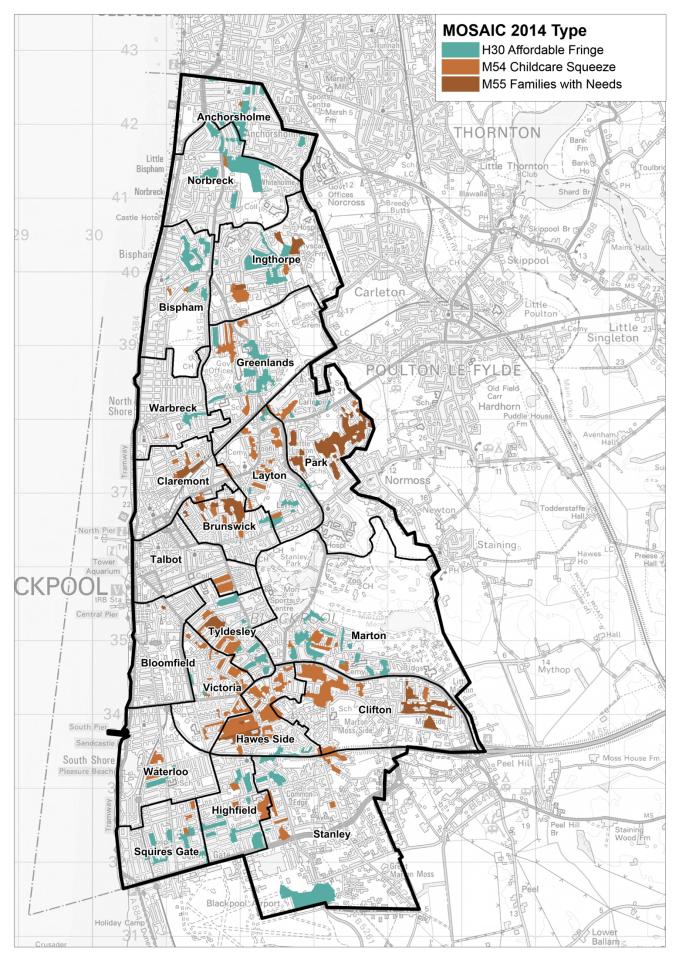
National Estimates
The British Crime Survey (2000) and National Psychiatric Morbidity Survey (2004) indicate that 8% of children aged under 16 years in the UK lived with an adult that has used illicit drugs in the last year, 2% with a class A drug user and 7% a Class C drug user.6
Drug Consumption in Blackpool
Public Health England (PHE) has calculated an estimate of the prevalence of opiate and/or crack cocaine use by local authorities. Blackpool has a prevalence that is significantly higher than the national average at more than double the national rate. This prevalence estimate equates to 1950 opiate and/or crack users living in Blackpool between the age of 15 and 65.
Figure 8 - Estimated prevalence of opiate and/or crack cocaine
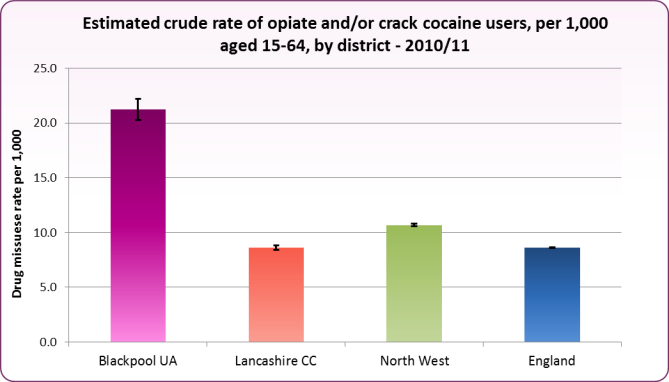 Source: Knowledge and Intelligence Team (North West)
Source: Knowledge and Intelligence Team (North West)
National Estimates Applied to Blackpool
It seems reasonable to assume that applying national estimates of parental drug misuse to the population of Blackpool will massively underestimate its extent. The mid 2013 population estimate for the number of under 16s living in Blackpool is 25,478 and the national estimates in relation to parental drug misuse has been applied to this in Figure 9.
Figure 9 - Minimum Estimate of the Number of Children Exposed to Parental Drug Misuse in Blackpool
|
|
National Prevalence (%)
|
Minimum estimate of the number of children in Blackpool
|
|
Under 16s living with an adult that has used illicit drugs in the last year
|
8%
|
2040
|
|
Under 16s living with an adult that has used a class A drugs in the last year
|
2%
|
460
|
|
Under 16s living with an adult that has used a class C drugs in the last year
|
7%
|
1860
|
|
Under 16s living with a parent who is drug dependant
|
2.8%
|
710
|
|
Under 16s living with an injecting drug user
|
0.6%
|
150
|
In the 12 months period, 01/10/2013 to 30/09/2014, 586 Blackpool clients in opiate treatment lived with children under the age of 18. This is a count of the number of clients and so this underestimates the number of children affected. The proportion of clients in opiate treatment who live with children under the age of 18 is much higher in Blackpool than the national average.
Period: 01/10/2013 to 30/09/2014Source: Diagnostic Outcomes Monitoring Executive Summary (DOMES) Quarter 2 2014/15
It would seem reasonable to estimate that only half of current opiate/crack users in Blackpool receive treatment in a given year based on the estimated prevalence of opiate/crack use in Blackpool and the number of clients in treatment. If we also factor in that clients may have more than one child it becomes clear that applying the national estimates of parental drug use produce large under estimates. A more reasonable figure for the number of children experiencing parental opiate and/or crack cocaine use would seem to be 1,500 - 2,500 children.
Figure 11illustrates where clients reside who have undertaken opiate and/or crack cocaine treatment in the period 01/04/2014 to 31/03/2015 and who live with children.
Figure 11 - Map of Clients in Opiate and/or crack cocaine Treatment who Live with Children Under the age of 18
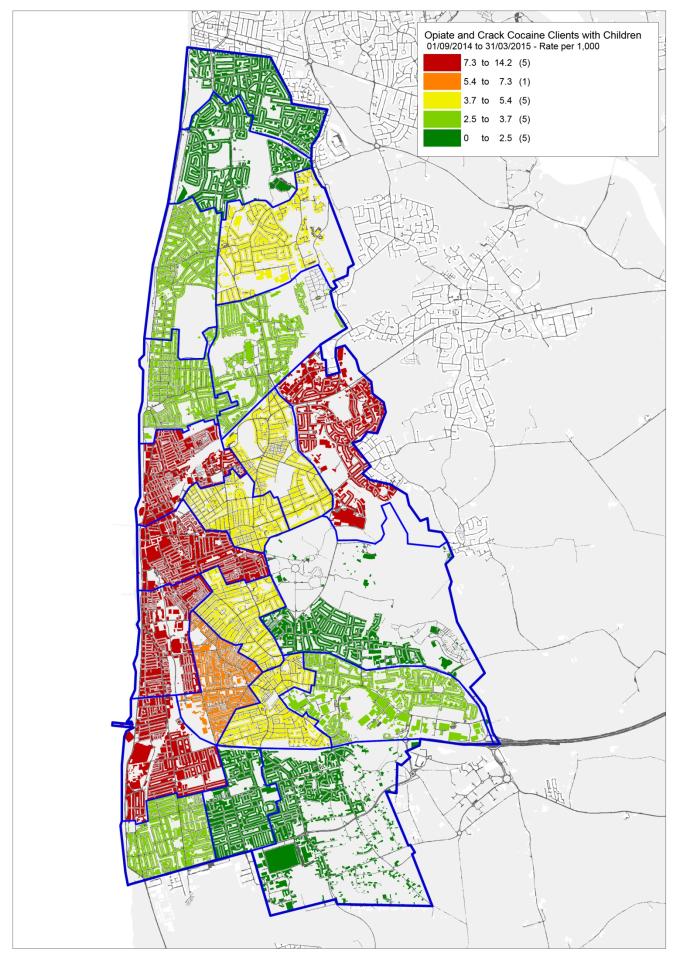
It is difficult to define what is meant by the term mental ill-health in this scenario. Mental ill-health can refer to many different conditions of varying levels of severity. The impact to an individual, their family or children will be dependent on many different factors, particularly whether they receive appropriate treatment and whether they receive adequate support.
Estimated Prevalence of Parental Mental Ill-Health
Public Health England has produced estimates of the prevalence of common mental health conditions by local authority. Prevalence of many of these conditions is higher in Blackpool than England as a whole. The estimated prevalence of mixed anxiety and depressive disorders, in those aged 16-74, in Blackpool is 11.5% compared to 8.9% in England.7 This measure will be used as a proxy for the prevalence of mental-ill health. We know from the 2011 census that there are 15,138 households with children in Blackpool.8 If we apply the prevalence, taking into account household composition, to the number of households in Blackpool with children we have an estimate of 3,100 households in Blackpool with children where an adult is experiencing mental ill-health. This figure needs to be treated with caution as we do not know whether, in multiple adult households, the existence of one adult experiencing mental ill-health increases the probability of the other adult/s in the household experiencing mental ill-health. If we also take into account that many families will have multiple children, it would seem reasonable to assume that between 4,500 and 5,500 children live in families where an adult experiences mental ill-health.
The National Institute for Health and Care Excellence (NICE) estimate that 12% of mothers require support during pregnancy or in the post natal period. Applying this to Blackpool would suggest that approximately 210 mothers would require this support each year.7
[] Victoria Manning, David W Best, Nathan Faulkner and Emily Titherington. New estimates of the number of children living with substance misusing parents: results from UK national household surveys. BMC Public Health 2009, 9:377
[] PHE, Local Alcohol Profiles for England
] PHE, National Drug Treatment Monitoring System
PHE, Public Health Outcomes Framework Indicator 2.18 - Alcohol related admissions to hospital - narrow definition
PHE, Public Health Outcomes Framework, Indicator 4.06i - Age-standardised rate of mortality from liver disease in persons less than 75 years of age per 100,000 population
Victoria Manning, David W Best, Nathan Faulkner and Emily Titherington. New estimates of the number of children living with substance misusing parents: results from UK national household surveys. BMC Public Health 2009, 9:377
PHE, Common Mental Health Disorders
Census 2011 - Table QS115UK Household composition (alternative child and adult definitions)